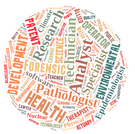
Science Career Exploration
- Subject:
- Career and Technical Education
- Engineering
- Life Science
- Physical Science
- Social Science
- Material Type:
- Lesson
- Lesson Plan
- Author:
- STEMToolkit Administrator
- Date Added:
- 05/09/2021

Science Career Exploration

The students will explore, research, and become more knowledgeable in various careers in science. Students will apply this knowledge by creating a lab, hands-on activity, visual, or video. Opportunity for student choice is provided and creativity to apply their understanding is given.
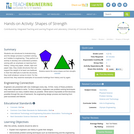
Students are introduced to brainstorming and the design process in problem solving as it relates to engineering. They perform an activity to develop and understand problem solving with an emphasis on learning from history. Using only paper, straws, tape and paper clips, they create structures that can support the weight of at least one textbook. In their first attempts to build the structures, they build whatever comes to mind. For the second trial, they examine examples of successful buildings from history and try again.
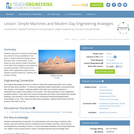
Students apply the mechanical advantages and problem-solving capabilities of six types of simple machines (wedge, wheel and axle, lever, inclined plane, screw, pulley) as they discuss modern structures in the spirit of the engineers and builders of the great pyramids. While learning the steps of the engineering design process, students practice teamwork, creativity and problem solving.
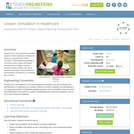
Students learn how engineering design is applied to solve healthcare problems by using an engineering tool called simulation. While engineering design is commonly used to study and design everything from bridges, factories, airports to space shuttles, the use of engineering design to study healthcare administration and delivery is a relatively new concept.
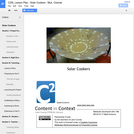
In this project students will research and then build a basic solar cooker shell made out of cardboard. Then they will run a variety of materials through experiments. Data from the experiments will be used to determine which materials should be added to the solar cooker shell to improve its ability to heat up food.
This project was created as a collaboration between a science and an engineering/woodshop class. The engineering class researched and build the basic solar cooker cardboard shells. The science class tested additional materials to add to the shells to improve the solar cookers. Then the engineering class, following the directions from reports created by the science class, added the materials to the solar cooker shells to create the final products.
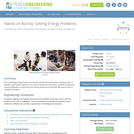
The culminating energy project is introduced and the technical problem solving process is applied to get students started on the project. By the end of the class, students should have a good perspective on what they have already learned and what they still need to learn to complete the project.
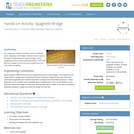
Civil engineers design structures such as buildings, dams, highways and bridges. Student teams explore the field of engineering by making bridges using spaghetti as their primary building material. Then they test their bridges to see how much weight they can carry before breaking.
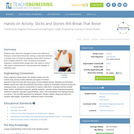
Students learn about the strength of bones and methods of helping to mend fractured bones. During a class demonstration, a chicken bone is broken by applying a load until it reaches a point of failure (fracture). Then, working as biomedical engineers, students teams design their own splint or cast to help repair a fractured bone, learning about the strength of materials used.
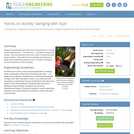
Students experientially learn about the characteristics of a simple physics phenomenon the pendulum by riding on playground swings. They use pendulum terms and a timer to experiment with swing variables. They extend their knowledge by following the steps of the engineering design process to design timekeeping devices powered by human swinging.
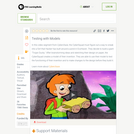
In this video segment from Cyberchase, learn about the importance of creating a model as the CyberSquad designs a giant Trojan Ducky that will help them enter a fort without being noticed.

This Piktochart contains lesson plan information for teaching middle school age students about the engineering design process and bridge design. Students will be able to:Describe and identify the most common types of bridges.Describe the strenghths and weaknesses of each type of bridge.Explain constraints and tension and show how it works on each bridge type.Construct a bridge using one of the common bridge types that can support a predetermined amount of weight.Included in this Piktochart Lesson Plan1. Definition of types of bridges2. Example sketches of types of bridges (Google Slide Format)3. Quick Design Paper Bridge Challenge4. Popsicle Stick Bridge Challenge from Instuctables.com
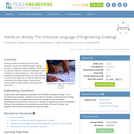
Students practice the ability to produce clear, complete, accurate and detailed design drawings through an engineering design challenge. Using only the specified materials, teams are challenged to draw a design for a wind-powered car. Then, they trade engineering drawings with another group and attempt to construct the model cars in order to determine how successfully the original design intentions were communicated through sketches, dimensions and instructions.
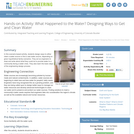
In this scenario-based activity, students design ways to either clean a water source or find a new water source, depending on given hypothetical family scenarios. They act as engineers to draw and write about what they could do to provide water to a community facing a water crisis. They also learn the basic steps of the engineering design process.
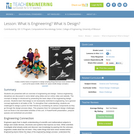
Students are presented with an overview of engineering and design. Various engineering disciplines are discussed in some detail using slides and an online video and website. The concept of design is introduced by presenting the basic steps of the engineering design process. Students learn that design is not necessarily restricted to engineering, but a general concept applicable to all walks of life. To strengthen their understanding, students are challenged to design a picnic for their friends by considering its various components as they go through the design process steps. This prepares them for subsequent design challenges such as those in the associated activities of this unit. A PowerPoint® presentation, pre/post quizzes and worksheet are provided.
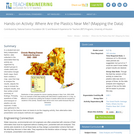
In a student-led and fairly independent fashion, data collected in the associated field trip activity are organized by student groups to create useful and informative Google Earth maps. Each team creates a map, uses that map to analyze the results, adjusts the map to include the analysis results, and then writes a brief summary of findings. Primarily, questions of fate-and-transport of plastics are are explored. If data was gathered in the field trip but the teacher does not desire to do the mapping activity, then alternative data presentation and analysis methods are suggested.

In this activity, learners create and experiment with wind tubes. These tubes are a playful and inventive way to explore the effect that moving air has on objects. Construction uses everyday materials such as a fan and embroidery hoops. It's fun to make things fly out of or float in the tubes, and to adjust the tubes to change the way the objects fly. The activity requires a significant amount of time and resources to build and may require adult help in construction. Experimentation with the wind tubes is engaging for a wide age range of learners.
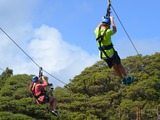
A park ranger needs to build a zipline to drop food supplies to her mentor park ranger at the bottom of a gorge. Unfortunately, she does not have the instructions to build the zipline according to the proper specifications. Without directions, she is unsure of the correct angles to attach her zipline to each tree. Additionally, she needs to figure out how to open the chute to drop the food supplies. Challenge: Create a zip line that will release from her bucket (paper cup) the food supplies (represented by a marble) onto the target (placed 5/8 of the way down the zipline) before the gear reaches the opposite end of the zip line.